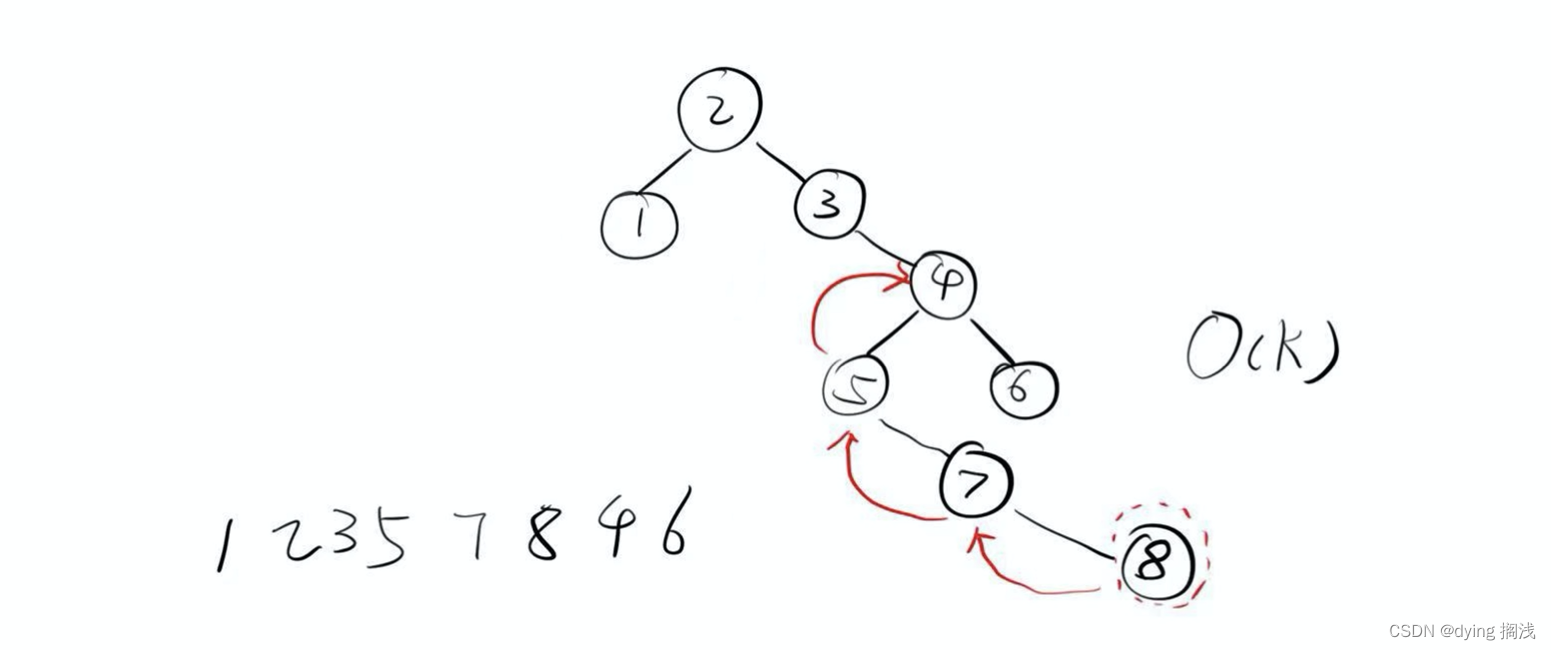【算法自由之路】二叉树的递归套路
创始人
2024-05-22 03:20:36
0次
【算法自由之路】二叉树的递归套路
预热,二叉树的后继节点
话不多说,首先是一道练手题,寻找二叉树任意给定节点的后继节点,此二叉树具备一个指向父节点的指针。
后继节点:在中序遍历中于给定节点后一个打印的节点
public static class TreeNode {public int val;public TreeNode left;public TreeNode right;public TreeNode parent;public TreeNode(int val) {this.val = val;}}
这道题其实主要考验的是分类讨论和找规律的能力。首先理解中序遍历对每个子树打印顺序都是 左 中 右。比如下图这个树
做分类讨论其实就两个情况:
- 该节点有右节点:后继为右节点的最左节点
- 该节点没有右节点:后继节点为向上找,第一次子节点是父节点的左孩子的父节点,比如 8 的后继就是 4
对于情况 2 我们其实可以反推来理解, 4 节点的前驱节点应该是 左子树的最右的一个节点。

package algorithmic.base.tree;/*** @program: algorithmic-total-solution* @description: 查找二叉树的后继节点,* @author: wangzibin* @create: 2023-01-10**/
public class FindNextNode {public static class TreeNode {public int val;public TreeNode left;public TreeNode right;public TreeNode parent;public TreeNode(int val) {this.val = val;}@Overridepublic String toString() {return "TreeNode{" +"val=" + val +'}';}}public static void print(TreeNode node) {if (node == null) {return;}print(node.left);System.out.print(node.val);print(node.right);}public static TreeNode findNextNode(TreeNode node) {if (node == null) {return null;}TreeNode result = null;// 如果有右孩子,后继节点是右孩子的最左节点if (node.right != null) {result = node.right;while (result.left != null) {result = result.left;}return result;}// 如果没有右孩子,向上找第一个子孩子是左节点的父节点 (有点绕,看代码)result = node.parent;// 注意最右节点没有后继节点while (node.parent != null && node != result.left) {node = node.parent;result = node.parent;}return result;}public static void main(String[] args) {TreeNode head = new TreeNode(2);TreeNode node1 = new TreeNode(1);TreeNode node3 = new TreeNode(3);TreeNode node4 = new TreeNode(4);TreeNode node5 = new TreeNode(5);TreeNode node6 = new TreeNode(6);TreeNode node7 = new TreeNode(7);TreeNode node8 = new TreeNode(8);head.left = node1;node1.parent = head;head.right = node3;node3.parent = head;node3.right = node4;node4.parent = node3;node4.left = node5;node5.parent = node4;node4.right = node6;node6.parent = node4;node5.right = node7;node7.parent = node5;node7.right = node8;node8.parent = node7;print(head);System.out.println();System.out.println(findNextNode(node1));System.out.println(findNextNode(head));System.out.println(findNextNode(node3));System.out.println(findNextNode(node5));System.out.println(findNextNode(node7));System.out.println(findNextNode(node8));System.out.println(findNextNode(node4));System.out.println(findNextNode(node6));}}递归套路
二叉树的递归套路有点像拆分子任务,将要求的最终结果分给每个分支去做
在实际应用中,对于一个整个树的问题,假设可以向左右子树要任何信息,整合信息后得出最终结果
整个拆分任务的操作我们交给了堆栈去做
递归套路 1 判断一个二叉树是平衡二叉树
平衡二叉树定义:对于树中任意一个节点,其左子树和右子树的高度差不超过 1。
这里假设我可以向左右子树获取任何信息,那对于判断我是否是平衡二叉树的关系信息是:
- 子树高度
- 子树是否是平衡二叉树
于是我可以定义这样一个返回结构
public static class NodeInfo {public boolean isBalanced;public int high;public NodeInfo(boolean isBalanced, int high) {this.isBalanced = isBalanced;this.high = high;}}
最终代码很简单
public class BalanceTree {public static class TreeNode {int val;TreeNode left;TreeNode right;TreeNode() {}TreeNode(int val) {this.val = val;}TreeNode(int val, TreeNode left, TreeNode right) {this.val = val;this.left = left;this.right = right;}}public static class NodeInfo {public boolean isBalanced;public int high;public NodeInfo(boolean isBalanced, int high) {this.isBalanced = isBalanced;this.high = high;}}public boolean isBalanced(TreeNode root) {return getNodeInfo(root).isBalanced;}public NodeInfo getNodeInfo(TreeNode node) {if (node == null) {return new NodeInfo(true, 0);}// 获取左子树信息NodeInfo left = getNodeInfo(node.left);// 获取右子树信息NodeInfo right = getNodeInfo(node.right);// 如果左右子树都平衡且高度差为 1 则我也平衡boolean isBalanced = left.isBalanced && right.isBalanced && Math.abs(left.high - right.high) <= 1;// 我的高度为左右子树最大高度 +1int high = Math.max(left.high, right.high) + 1;return new NodeInfo(isBalanced, high);}}
可以直接到 leetcode 验证 平衡二叉树
感受到二叉树的递归套路的魅力了吗?关键点在于:
- 思考 当前 节点 与 左右子节点的关系 (一般的我们可以以 以 与当前节点有关 和 与当前节点无关 来进行分类讨论 )
- 向左右子节点获取什么信息能够计算出我的信息
- 整合信息,定义结构
递归套路 2 计算给定树结构中二叉搜索子树的最大键和值
首先定义二叉搜索数 : 对于树中任意一个节点,其左树都小于该节点,右树都大于该节点
需要向左右节点要的信息:
- 树的最大值
- 树的最小值
- 是否是二叉搜索树
- 当前树的键和值
- 二叉搜索子树的最大键和值
在递归中就需要讨论最终结果是否与当前节点有关了,直接看代码
package algorithmic.base.tree;import javax.xml.soap.Node;/*** @program: algorithmic-total-solution* @description: 二叉搜索子树最大键和值 https://leetcode.cn/problems/maximum-sum-bst-in-binary-tree/* @author: wangzibin* @create: 2023-01-11**/
public class MaxSumBST {public static class TreeNode {int val;TreeNode left;TreeNode right;TreeNode() {}TreeNode(int val) {this.val = val;}TreeNode(int val, TreeNode left, TreeNode right) {this.val = val;this.left = left;this.right = right;}}public static class NodeInfo {// 当前节点子树最大值private int max;private int min;private boolean isBst;private int bstSum;private int bstMaxSum;@Overridepublic String toString() {return "NodeInfo{" +"max=" + max +", min=" + min +", isBst=" + isBst +", bstSum=" + bstSum +", bstMaxSum=" + bstMaxSum +'}';}}public static NodeInfo getInfo(TreeNode node) {if (node == null) {NodeInfo empty = new NodeInfo();empty.isBst = true;empty.min = Integer.MAX_VALUE;empty.max = Integer.MIN_VALUE;return empty;}NodeInfo leftInfo = getInfo(node.left);NodeInfo rightInfo = getInfo(node.right);NodeInfo current = new NodeInfo();current.max = max(node.val, leftInfo.max, rightInfo.max);current.min = min(node.val, leftInfo.min, rightInfo.min);// 判断是否与我有关, 当且仅当我也是二叉搜索树时最大值才与我有关,否则只需要比较子树值即可if (leftInfo.isBst && rightInfo.isBst && leftInfo.max < node.val && rightInfo.min > node.val) {// 左右子树都是搜索树,且 左子树最大值 小于 当前节点值 ,右子树最小值 大于 当前节点值,则可讨论与当前节点有关的情况current.isBst = true;current.bstSum = node.val + leftInfo.bstSum + rightInfo.bstSum;current.bstMaxSum = max(current.bstSum, leftInfo.bstMaxSum, rightInfo.bstMaxSum);} else {current.isBst = false;current.bstMaxSum = Math.max(leftInfo.bstMaxSum, rightInfo.bstMaxSum);}return current;}public static int max(int num1, int num2, int num3) {return Math.max(Math.max(num1, num2), num3);}public static int min(int num1, int num2, int num3) {return Math.min(Math.min(num1, num2), num3);}public static int maxSumBST(TreeNode root) {if (root == null) {return 0;}int bstMaxSum = getInfo(root).bstMaxSum;return Math.max(bstMaxSum, 0);}public static void main(String[] args) {TreeNode treeNode1 = new TreeNode(1);treeNode1.left = null;TreeNode treeNode10 = new TreeNode(10);TreeNode treeNode5 = new TreeNode(-5);TreeNode treeNode20 = new TreeNode(20);treeNode1.right = treeNode10;treeNode10.left = treeNode5;treeNode10.right = treeNode20;System.out.println(maxSumBST(treeNode1));}}
验证正确性 1373. 二叉搜索子树的最大键值和
相关内容
热门资讯
安卓子系统windows11,...
你知道吗?最近科技圈可是炸开了锅,因为安卓子系统在Windows 11上的兼容性成了大家热议的话题。...
电脑里怎么下载安卓系统,电脑端...
你有没有想过,你的电脑里也能装上安卓系统呢?没错,就是那个让你手机不离手的安卓!今天,就让我来带你一...
索尼相机魔改安卓系统,魔改系统...
你知道吗?最近在摄影圈里掀起了一股热潮,那就是索尼相机魔改安卓系统。这可不是一般的改装,而是让这些专...
安卓系统哪家的最流畅,安卓系统...
你有没有想过,为什么你的手机有时候像蜗牛一样慢吞吞的,而别人的手机却能像风一样快?这背后,其实就是安...
安卓最新系统4.42,深度解析...
你有没有发现,你的安卓手机最近是不是有点儿不一样了?没错,就是那个一直在默默更新的安卓最新系统4.4...
android和安卓什么系统最...
你有没有想过,你的安卓手机到底是用的是什么系统呢?是不是有时候觉得手机卡顿,运行缓慢,其实跟这个系统...
平板装安卓xp系统好,探索复古...
你有没有想过,把安卓系统装到平板上,再配上XP系统,这会是怎样一番景象呢?想象一边享受着安卓的便捷,...
投影仪装安卓系统,开启智能投影...
你有没有想过,家里的老式投影仪也能焕发第二春呢?没错,就是那个曾经陪你熬夜看电影的“老伙计”,现在它...
安卓系统无线车载carplay...
你有没有想过,开车的时候也能享受到苹果设备的便利呢?没错,就是那个让你在日常生活中离不开的iOS系统...
谷歌安卓8系统包,系统包解析与...
你有没有发现,手机更新换代的速度简直就像坐上了火箭呢?这不,最近谷歌又发布了安卓8系统包,听说这个新...
微软平板下软件安卓系统,开启全...
你有没有想过,在微软平板上也能畅享安卓系统的乐趣呢?没错,这就是今天我要跟你分享的神奇故事。想象你手...
coloros是基于安卓系统吗...
你有没有想过,手机里的那个色彩斑斓的界面,背后其实有着一个有趣的故事呢?没错,我要说的就是Color...
安卓神盾系统应用市场,一站式智...
你有没有发现,手机里的安卓神盾系统应用市场最近可是火得一塌糊涂啊!这不,我就来给你好好扒一扒,看看这...
黑莓平板安卓系统升级,解锁无限...
亲爱的读者们,你是否还记得那个曾经风靡一时的黑莓手机?那个标志性的全键盘,那个独特的黑莓体验,如今它...
安卓文件系统采用华为,探索高效...
你知道吗?最近安卓系统在文件管理上可是有了大动作呢!华为这个科技巨头,竟然悄悄地给安卓文件系统来了个...
深度系统能用安卓app,探索智...
你知道吗?现在科技的发展真是让人惊叹不已!今天,我要给你揭秘一个超级酷炫的话题——深度系统能用安卓a...
安卓系统的分区类型,深度解析存...
你有没有发现,你的安卓手机里藏着不少秘密?没错,就是那些神秘的分区类型。今天,就让我带你一探究竟,揭...
安卓系统铠无法兑换,揭秘无法兑...
最近是不是有很多小伙伴在玩安卓系统的游戏,突然发现了一个让人头疼的问题——铠无法兑换!别急,今天就来...
汽车安卓系统崩溃怎么刷,一键刷...
亲爱的车主朋友们,你是否曾遇到过汽车安卓系统崩溃的尴尬时刻?手机系统崩溃还能重启,但汽车系统崩溃了,...
miui系统可以刷安卓p系统吗...
亲爱的手机控们,你是否对MIUI系统情有独钟,同时又对安卓P系统的新鲜功能垂涎欲滴?今天,就让我带你...
